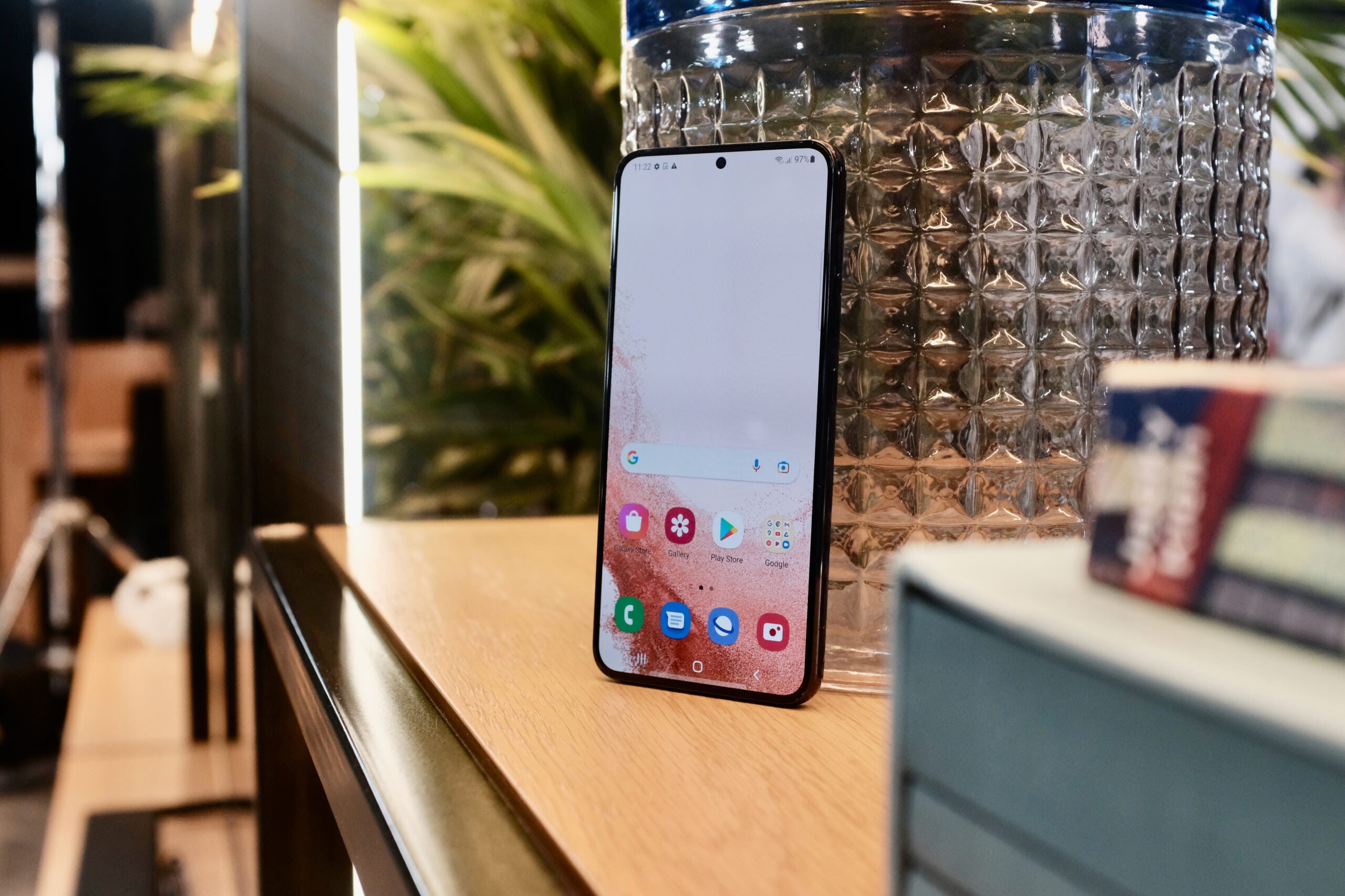Verdict
The Samsung Galaxy S22 Plus is a good device, even if it doesn’t stand as one of the newest Samsung phones.
Pros
- Brilliant screen
- Great camera
- Attractive design
- Strong performance
Cons
- Battery life could be better
- Expensive
Availability
- UKRRP: £949
- USARRP: $999.99
- EuropeRRP: €1059
Introduction
The Galaxy S22 Plus sits in the middle of Samsung’s Galaxy S22 range – it isn’t as feature-rich as the S22 Ultra, but it offers more screen real to play with than the Galaxy S22.
With a large screen, a versatile camera array, and impressive performance capabilities, it seems to have everything you might want in a phone, even if Samsung has released the Galaxy S23 Plus as a successor.
Design and Screen
- Attractive frosted glass finish
- Comfortable and manageable to hold
- Gorgeous screen
The moment I took it out of the box it was immediately apparent that the Samsung Galaxy S22 Plus is without a doubt a good looking phone, even more so when in the pretty pink shade of our review handset.
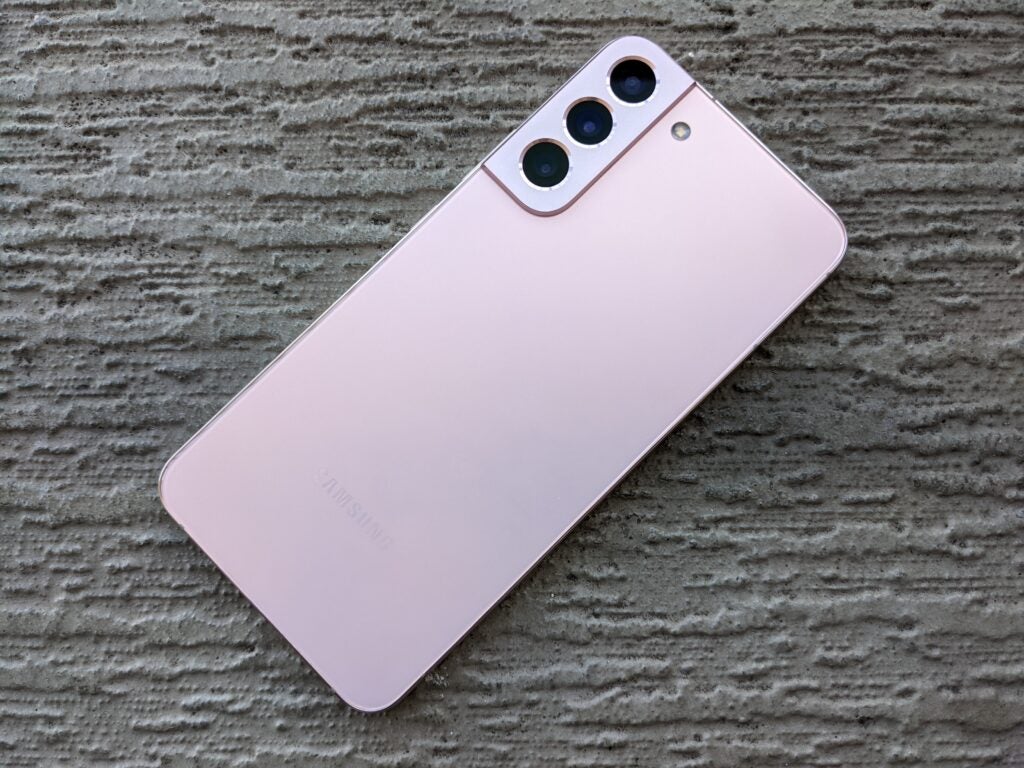
With glossy metal sides and a subtle frosted glass back (a qualitative improvement on the unfortunate plastic panel of the Galaxy S21), this phone both looks and feels like a premium handset. The front-facing camera is housed in a small holepunch notch in the centre of the display, while the triple rear cameras are packed together in a gently curved module on the rear, which hardly protrudes at all from the back.
I found this handset perfectly manageable and comfortable to use with just one hand, weighing 195g and being very slim at 7.6mm. Taking all of this in mind, many users could well prefer this over the enormous and somewhat unwieldy S22 Ultra which we found difficult to use one handed during testing.
Fortunately this phone isn’t just a pretty face; it’s tough too, with an IP68 rating showing strong resistance against dust or water ingress, and with the front and back being made out of highly durable Gorilla Glass Victus Plus. During testing the device has survived the wear and tear of everyday use and an accidental drop unscathed.
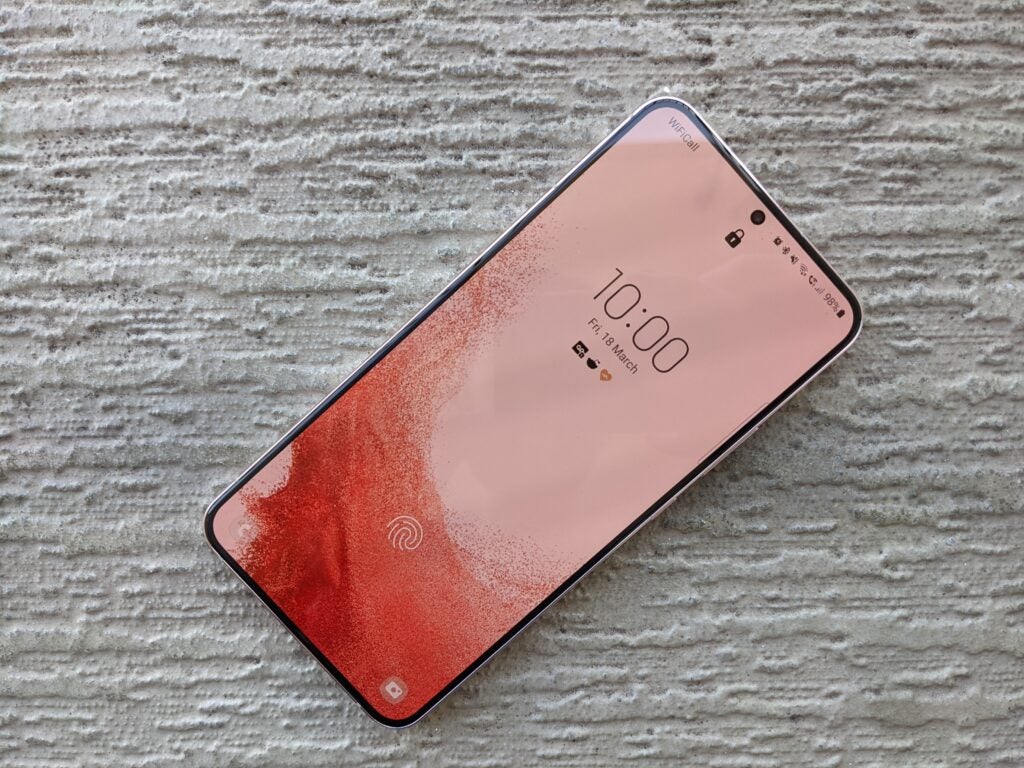
The 6.6-inch AMOLED screen is one of the areas where this device really excels. I’ve been finding it hard to switch off this gorgeous display, which is smooth, bright, and has brilliant colour accuracy making content really shine.
Whether watching videos, playing games, or scrolling on social media, this screen is excellent at any task it turned its hand to and it was just a joy to use.
It’s worth noting that the resolution isn’t at the absolute peak of what we’ve seen on smartphones, being bettered by the Samsung Galaxy S22 Ultra, the Sony Xperia 1 III, and the Xiaomi 12 Pro to name three phones with WQHD+ resolutions. However I never particularly felt this to be a big loss, even when streaming high quality content. Content uniformly looked sharp during testing and I’ve found myself regularly using it to stream video while commuting. Samsung stuck with the same resolution for the S23 Plus.
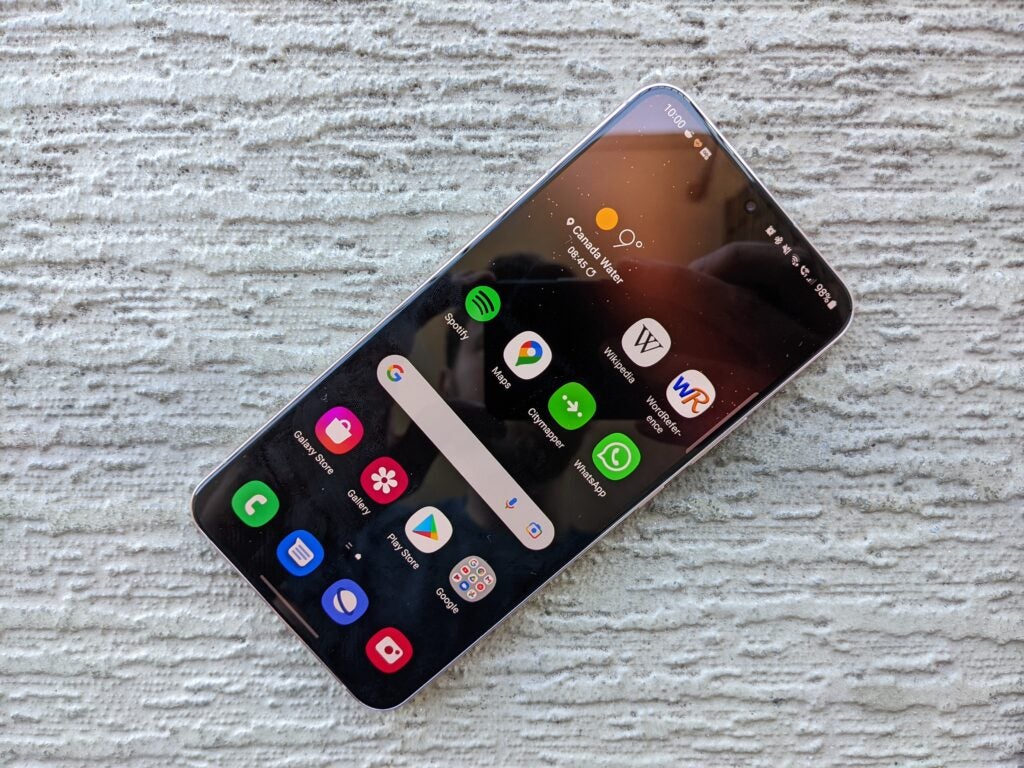
While this particular screen spec might not have been at the very top of its game, it’s fair to say that the rest very much are. The 120Hz adaptive refresh rate ensures super smoothness when you need it most, like playing 120fps games or scrolling through social media feeds, but automatically reduces otherwise to save battery life. The HDR10+ support makes supported content, such as many Netflix shows, really “pop” out of the screen and look more appealing than ever. And the 1750 nits maximum brightness means that this screens stays legible and appealing even when you’re looking at it under the brightest sunlight.
Both the design and screen have been excellent in my experience, with the former being classy but resilient and the latter being entrancing to use even if the resolution is not best-in-class.
Camera
- Great camera results
- Versatile collection of sensors
There are three sensors in the camera module; a main wide angle camera, an ultrawide sensor, and a telephoto lens.
There are a couple of changes here compared to the older Galaxy S21 Plus, most notably the wide angle camera now being 50-megapixels rather than 12-megapixels, while the telephoto is now 10-megapixels with 3x optical zoom rather than 64-megapixels with 1.1x optical zoom. The ultrawide remains more or less the same, with a 120-degree field of view and a 12-megapixel resolution.
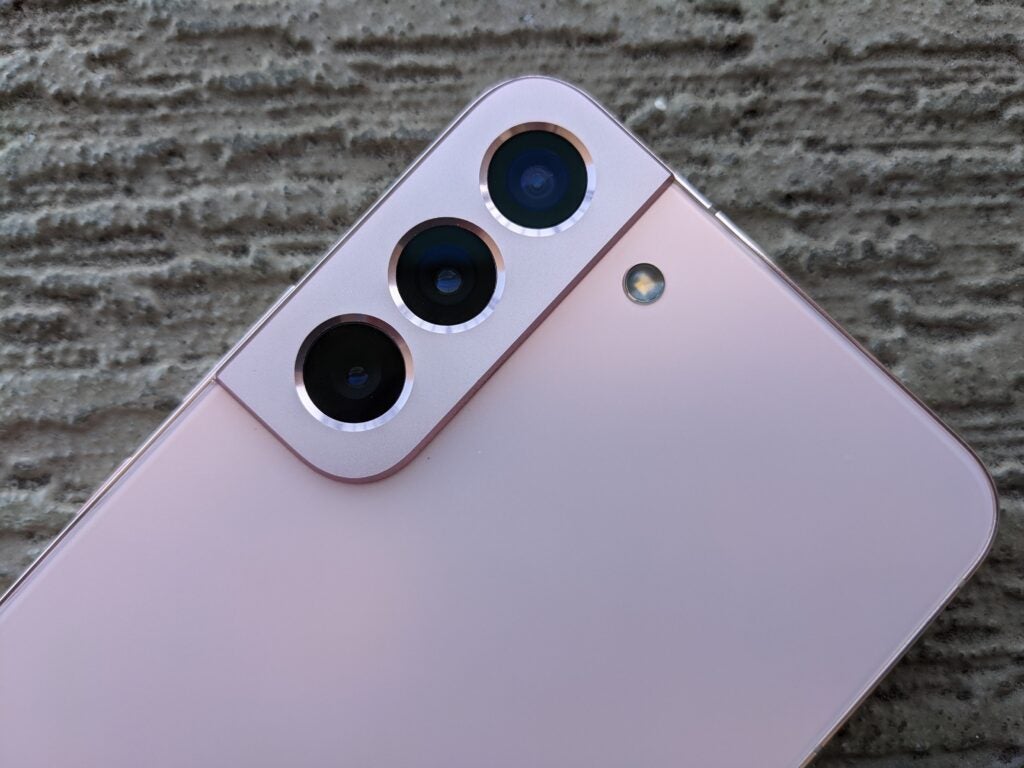
Running the two head-to-head, we found the Ultra offers more versatility, bearing in mind that it’s got an extra periscope telephoto camera on board, but I rarely find myself in need of a 10x optical zoom such as that anyway. This will only be really useful if you regularly need to capture images that are far away, like at concerts or sports matches. But given the state of the world and how steady you need to hold the Ultra to get good results in these conditions, it’s far from a deal breaker in my mind.
In everyday scenarios I found that whichever lens you choose to use, you’ll find that the images you take are packed with detail and colour. In fact, you might find colour to be a little over-emphasised in some contexts. I personally prefer the more neutral true to life results you get using a Pixel 7 Pro or iPhone 14 Pro, though the Samsung approach to image processing will likely go down very well with Instagram addicts.

For example, I took the above image with the main sensor on a very overcast and rainy day, and the depth of colours were still emphasized where other cameras could have churned out a more miserable image.

The above image was taken by the main camera on a sunnier day in Barcelona; standing in the same position, I took the below picture using the ultrawide sensor.

As you can see, there’s a fairly uniform look to the images when taken by those different sensors, without there being a huge drop-off in quality or tone between the two.

Again, the above picture was taken with the main camera on a cloudy day in London, while the below was taken from the same position with the ultrawide sensor instead.

It’s always handy to have high-performing secondary sensors such as this for different contexts. When I wanted to squeeze more into the frame when looking down the canal, I again could use the ultrawide to get a better results than the main camera:
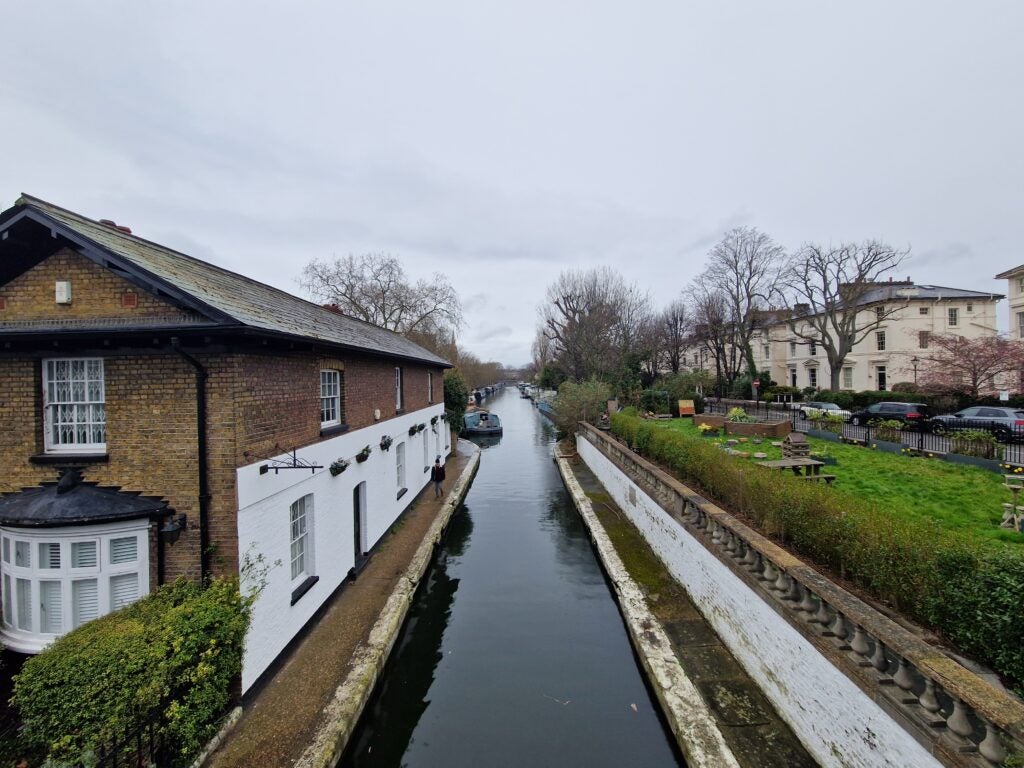
The telephoto sensor, equipped with 3x optical zoom, is another useful addition to your photography arsenal. Heading out of the office in the late afternoon, I took the below image with the main sensor:
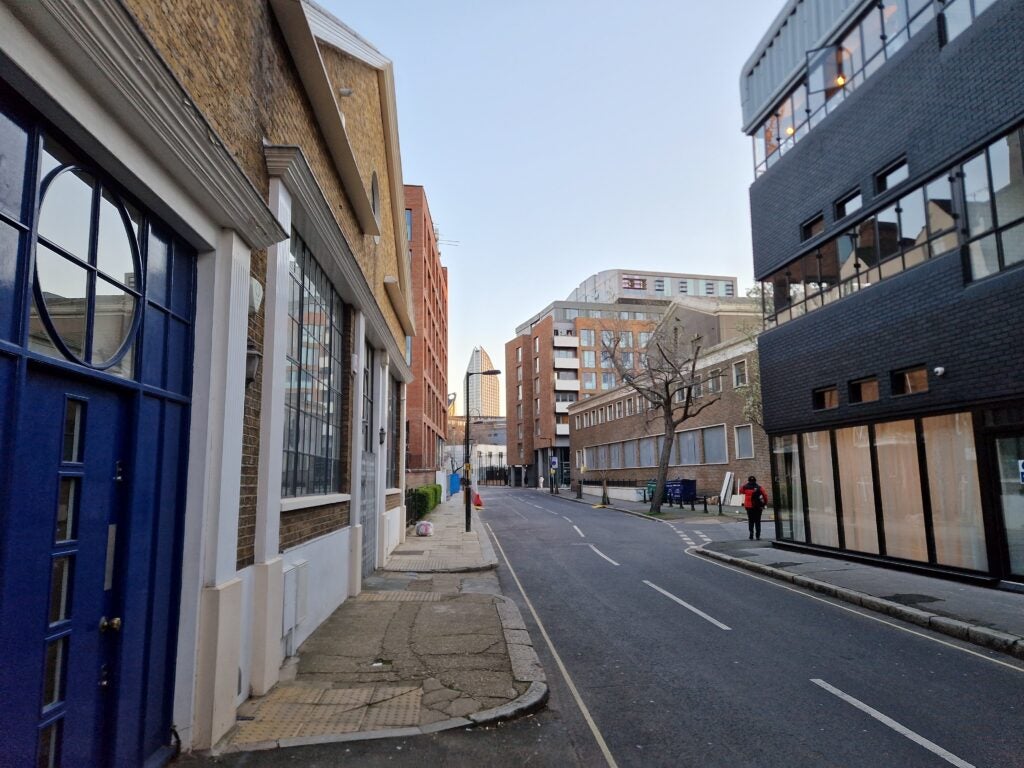
Then, using the telephoto sensor to zoom in on the distant office block, this was the resulting photo:
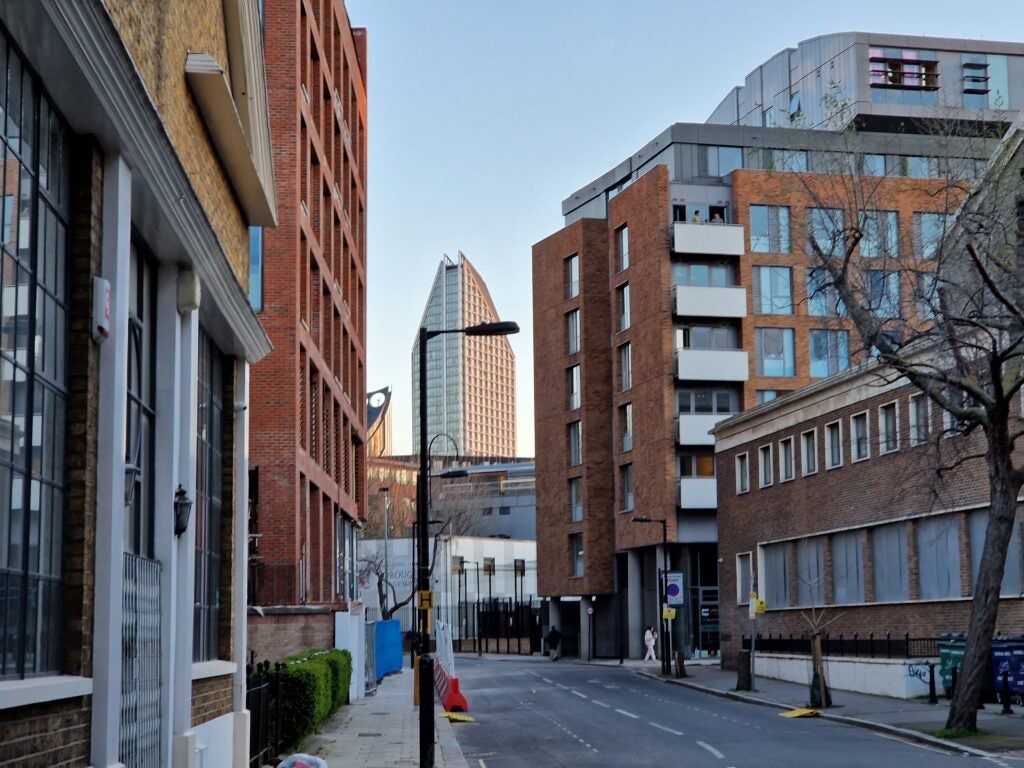
As you can see, it still appears sharp and lively, despite such an impressive level of zoom.

Turning to lowlight photography, and I tried out the camera first without Night Mode switched on, the result on which you can see above. Then, I tried out the same view with Night Mode applied, as shown below:

Both results are good, but the colours are better preserved when Night Mode is applied. In another context, where there weren’t so many bright lights to deal with, I tried it once again.

Taken very late, with nothing but moonlight for illumination, there’s still quite a lot of detail here even though there’s not much colour. But when tried with Night Mode on, as below, much of the colour has been restored for a more attractive photo:

As you can see, you can count on the Galaxy S22 Plus’ rear camera system to deliver impressive pictures in a variety of different contexts.

The selfie camera, which clocks in at 32-megapixels, also delivers sharp and punchy images, with an excellent bokeh effect that neatly cuts around the subject for an impactful “popping” effect.
Overall, I was very happy with the photographic performance, and it’s clear that this phone has a versatile and high-quality camera setup.
Performance
- Exynos 2200 chipset on board
- Very good all-round performance
There are two potential variants within the S22 Plus models when it comes to the chipset, with some running on the Snapdragon 8 Gen 1 (in the US and India, among others) and the Exynos 2200 (mostly in Europe), and the latter is the one that we tested. Samsung switched up this approach with S23, sticking to the same Snapdragon 8 Gen 2 for Galaxy chip across the whole line.
You’d expect a flagship device such as this to excel when the processor is put through its paces, and fortunately, this handset met all our expectations.
You’ll notice that it has no problem whatsoever when dealing with whichever everyday apps you’re using on the day-to-day, and when booting up serious games the phone is a delight, easily able to handle the most demanding titles on their highest available settings.
Here are the full benchmark tests we recorded when putting the processor through its paces:
The Galaxy S22 Plus’ CPU scores put it in the very top tier of Android handsets (though are easily beaten by the iPhone 13 range), and its GPU scores have only been beaten by the Red Magic 7, a dedicated gaming phone that only recently passed through our labs.
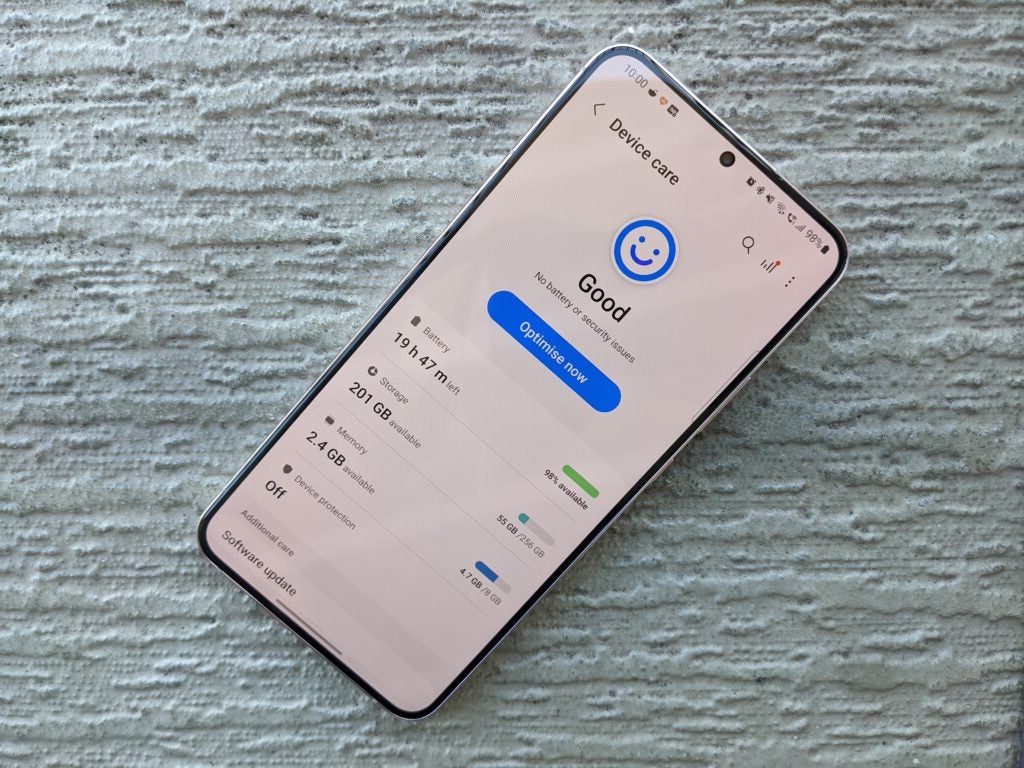
The software at launch was Android 12, with Samsung’s OneUI 4.1 software running on top –however this has since been bumped up to a more recent version and will pick up some of the features you’ll find on the S23 Plus. This is quite a heavy overlay as things go, that is very different from the bare-bones look you’ll get from Google’s phones.
Some notifications can be opened as a pop-up on your screen, rather than going into the full app every time, and there’s a taskbar hovering at the edge of the screen that you can swipe across to reveal your favourite apps. If you’re not used to these little features then you might find them getting in the way at first, but once you become accustomed to the changes then you’ll likely find them to be useful additions to the standard Android software, as I have during my week with the phone.
What’s more, Samsung has finally stepped up and promised five years of security updates and “up to” four generations of Android operating system with this device, significantly lengthening its usable lifespan.
Battery Life
- Decent but not exceptional battery life
- No charger included in the box
The phone runs off a 4500mAh capacity battery, which is a solid size without being exceptional. Despite this I still found the S22 Plus would comfortably see me through a day’s regular use. Things get a little worse with heavy use, however.
On a very busy day with this phone, where I streamed an hour of video, made plentiful use of Google Maps, read an eBook for three quarters of an hour, and spent a couple of hours scrolling through social media apps, like Twitter, I got through 5 hours of screen-on time and the battery was down to 5%.
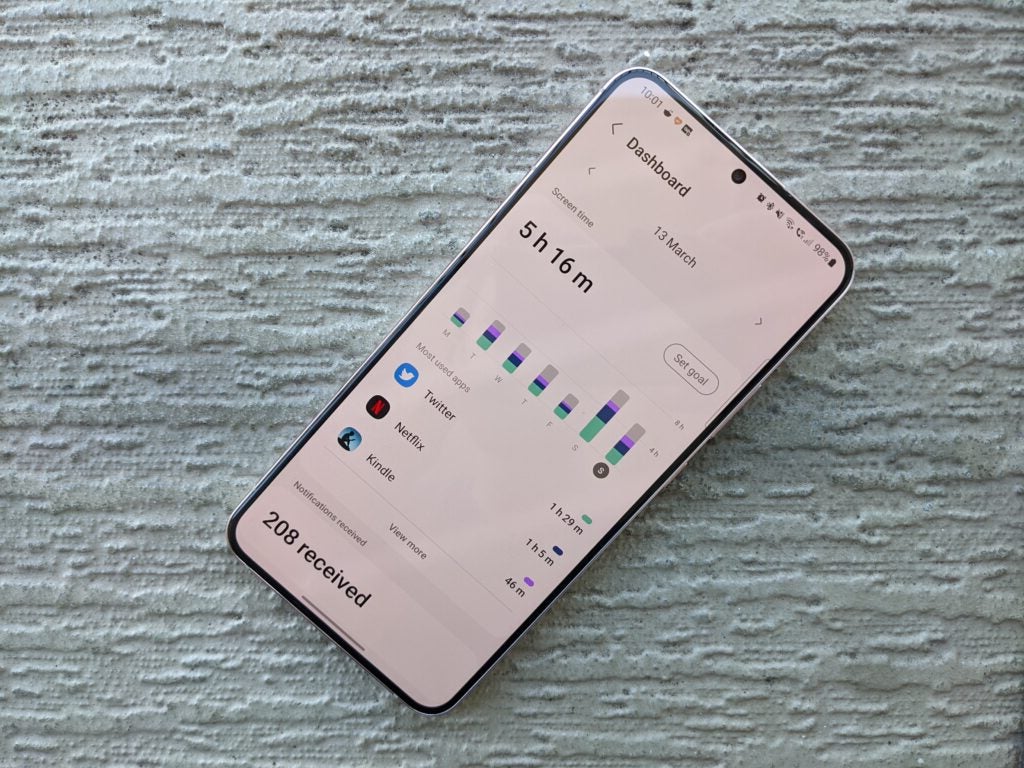
It just about got me through, without much breathing room to spare, but I’d consider this to be an unusually busy day for me – whereas days of more standard and sparing usage saw me having around 30% of the battery left when it came to bedtime. That said, there are plenty of other phones that can perform better than this, especially the iPhone 13 series and some mid-rangers like the Samsung Galaxy A52, so if battery is a high priority for you then this handset isn’t the best option.
The device is said to offer 45W fast-charging, however there’s no charging brick available in the box (ostensibly for the environmental reason of reducing electronic waste) so you’ll have to fork out for your own or re-use an older one. Samsung claims you can get 50% charge in just 20 minutes when using a 45W charger.
I used a 67W charger that I had held over from the OnePlus Nord CE 2 5G, but evidently, this was capped well below its rating as the phone charged up to 50% in 65 minutes, and all the way up to 100% in 140 minutes.
Latest deals
Should you buy it?
If you’re looking for an exceptional all-round flagship that’s not enormous or excessive. This phone covers all the bases of what you need from a flagship, without any obvious weak spots.
If you’re on a budget, or battery is a top priority. This is not a cheap phone by any means, and you can find many tempting alternatives at lower prices, which may also offer better battery life.
Final Thoughts
The existence of the Samsung Galaxy S23 series might mean that many disregard this phone in favour of its newer sibling. However, I’d say there’s still a lot here to like even a year on from release.
I remain highly impressed by pretty much every aspect of this device, from the immersive screen to the versatile camera system to the punchy performance, and it hits the sweet spot of not being bogged down with extra features while still offering a complete and comprehensive package to cover your needs.
How we test
We test every mobile phone we review thoroughly. We use industry standard tests to compare features properly and we use the phone as our main device over the review period. We’ll always tell you what we find and we never, ever, accept money to review a product.
FAQs
You can buy it in Phantom Black, White, Pink Gold, Green, Graphite, Sky Blue, Violet, or Cream
Yes, it is rated IP68, which means it is protected from dust ingress and can withstand immersion under water
Samsung has promised “up to four generations of Android OS upgrades and five years of security updates.”
Trusted Reviews test data
You can see a full breakdown of all the test data we collected reviewing the Galaxy S22 Plus, as well as how it performed compared to key rivals in the table below.
Geekbench 5 single core
Geekbench 5 multi core
sRGB
Adobe RGB
DCI-P3
Max brightness
1 hour video playback (Netflix, HDR)
30 minute gaming (intensive)
30 minute gaming (light)
1 hour music streaming (online)
1 hour music streaming (offline)
Time from 0-100% charge
Time from 0-50% charge
3D Mark – Wild Life
3D Mark – Wild Life Stress Test
3D Mark – Sling Shot Extreme
Full specs
You can see a detailed breakdown of the Galaxy S22 Plus’ specs and how they compare to the base S22 and top end S22 Ultra in the table below.
Jargon buster
IP rating
An abbreviation for ‘Ingress Protection Code’, which lets you know to what extent a device might be waterproof or dustproof.
5G
Offering faster download and upload speeds when compared to 4G. Great for game streaming and HDR video playback. Not supported everywhere yet and speeds vary wildly.
IP68
The most popular and useful level of water resistance. Usually means a device can withstand dust, dirt and sand and be submerged in 1.5m of water for 30m however this can sometimes vary. Read more in our IP68 guide for more.
Nits
The brightness level of a display. 300 nits is regarded as the minimum target for high-end screens.
Verdict
The Samsung Galaxy S22 Plus is a good device, even if it doesn’t stand as one of the newest Samsung phones.
Pros
- Brilliant screen
- Great camera
- Attractive design
- Strong performance
Cons
- Battery life could be better
- Expensive
Availability
- UKRRP: £949
- USARRP: $999.99
- EuropeRRP: €1059
Introduction
The Galaxy S22 Plus sits in the middle of Samsung’s Galaxy S22 range – it isn’t as feature-rich as the S22 Ultra, but it offers more screen real to play with than the Galaxy S22.
With a large screen, a versatile camera array, and impressive performance capabilities, it seems to have everything you might want in a phone, even if Samsung has released the Galaxy S23 Plus as a successor.
Design and Screen
- Attractive frosted glass finish
- Comfortable and manageable to hold
- Gorgeous screen
The moment I took it out of the box it was immediately apparent that the Samsung Galaxy S22 Plus is without a doubt a good looking phone, even more so when in the pretty pink shade of our review handset.

With glossy metal sides and a subtle frosted glass back (a qualitative improvement on the unfortunate plastic panel of the Galaxy S21), this phone both looks and feels like a premium handset. The front-facing camera is housed in a small holepunch notch in the centre of the display, while the triple rear cameras are packed together in a gently curved module on the rear, which hardly protrudes at all from the back.
I found this handset perfectly manageable and comfortable to use with just one hand, weighing 195g and being very slim at 7.6mm. Taking all of this in mind, many users could well prefer this over the enormous and somewhat unwieldy S22 Ultra which we found difficult to use one handed during testing.
Fortunately this phone isn’t just a pretty face; it’s tough too, with an IP68 rating showing strong resistance against dust or water ingress, and with the front and back being made out of highly durable Gorilla Glass Victus Plus. During testing the device has survived the wear and tear of everyday use and an accidental drop unscathed.

The 6.6-inch AMOLED screen is one of the areas where this device really excels. I’ve been finding it hard to switch off this gorgeous display, which is smooth, bright, and has brilliant colour accuracy making content really shine.
Whether watching videos, playing games, or scrolling on social media, this screen is excellent at any task it turned its hand to and it was just a joy to use.
It’s worth noting that the resolution isn’t at the absolute peak of what we’ve seen on smartphones, being bettered by the Samsung Galaxy S22 Ultra, the Sony Xperia 1 III, and the Xiaomi 12 Pro to name three phones with WQHD+ resolutions. However I never particularly felt this to be a big loss, even when streaming high quality content. Content uniformly looked sharp during testing and I’ve found myself regularly using it to stream video while commuting. Samsung stuck with the same resolution for the S23 Plus.

While this particular screen spec might not have been at the very top of its game, it’s fair to say that the rest very much are. The 120Hz adaptive refresh rate ensures super smoothness when you need it most, like playing 120fps games or scrolling through social media feeds, but automatically reduces otherwise to save battery life. The HDR10+ support makes supported content, such as many Netflix shows, really “pop” out of the screen and look more appealing than ever. And the 1750 nits maximum brightness means that this screens stays legible and appealing even when you’re looking at it under the brightest sunlight.
Both the design and screen have been excellent in my experience, with the former being classy but resilient and the latter being entrancing to use even if the resolution is not best-in-class.
Camera
- Great camera results
- Versatile collection of sensors
There are three sensors in the camera module; a main wide angle camera, an ultrawide sensor, and a telephoto lens.
There are a couple of changes here compared to the older Galaxy S21 Plus, most notably the wide angle camera now being 50-megapixels rather than 12-megapixels, while the telephoto is now 10-megapixels with 3x optical zoom rather than 64-megapixels with 1.1x optical zoom. The ultrawide remains more or less the same, with a 120-degree field of view and a 12-megapixel resolution.

Running the two head-to-head, we found the Ultra offers more versatility, bearing in mind that it’s got an extra periscope telephoto camera on board, but I rarely find myself in need of a 10x optical zoom such as that anyway. This will only be really useful if you regularly need to capture images that are far away, like at concerts or sports matches. But given the state of the world and how steady you need to hold the Ultra to get good results in these conditions, it’s far from a deal breaker in my mind.
In everyday scenarios I found that whichever lens you choose to use, you’ll find that the images you take are packed with detail and colour. In fact, you might find colour to be a little over-emphasised in some contexts. I personally prefer the more neutral true to life results you get using a Pixel 7 Pro or iPhone 14 Pro, though the Samsung approach to image processing will likely go down very well with Instagram addicts.

For example, I took the above image with the main sensor on a very overcast and rainy day, and the depth of colours were still emphasized where other cameras could have churned out a more miserable image.

The above image was taken by the main camera on a sunnier day in Barcelona; standing in the same position, I took the below picture using the ultrawide sensor.

As you can see, there’s a fairly uniform look to the images when taken by those different sensors, without there being a huge drop-off in quality or tone between the two.

Again, the above picture was taken with the main camera on a cloudy day in London, while the below was taken from the same position with the ultrawide sensor instead.

It’s always handy to have high-performing secondary sensors such as this for different contexts. When I wanted to squeeze more into the frame when looking down the canal, I again could use the ultrawide to get a better results than the main camera:

The telephoto sensor, equipped with 3x optical zoom, is another useful addition to your photography arsenal. Heading out of the office in the late afternoon, I took the below image with the main sensor:

Then, using the telephoto sensor to zoom in on the distant office block, this was the resulting photo:

As you can see, it still appears sharp and lively, despite such an impressive level of zoom.

Turning to lowlight photography, and I tried out the camera first without Night Mode switched on, the result on which you can see above. Then, I tried out the same view with Night Mode applied, as shown below:

Both results are good, but the colours are better preserved when Night Mode is applied. In another context, where there weren’t so many bright lights to deal with, I tried it once again.

Taken very late, with nothing but moonlight for illumination, there’s still quite a lot of detail here even though there’s not much colour. But when tried with Night Mode on, as below, much of the colour has been restored for a more attractive photo:

As you can see, you can count on the Galaxy S22 Plus’ rear camera system to deliver impressive pictures in a variety of different contexts.

The selfie camera, which clocks in at 32-megapixels, also delivers sharp and punchy images, with an excellent bokeh effect that neatly cuts around the subject for an impactful “popping” effect.
Overall, I was very happy with the photographic performance, and it’s clear that this phone has a versatile and high-quality camera setup.
Performance
- Exynos 2200 chipset on board
- Very good all-round performance
There are two potential variants within the S22 Plus models when it comes to the chipset, with some running on the Snapdragon 8 Gen 1 (in the US and India, among others) and the Exynos 2200 (mostly in Europe), and the latter is the one that we tested. Samsung switched up this approach with S23, sticking to the same Snapdragon 8 Gen 2 for Galaxy chip across the whole line.
You’d expect a flagship device such as this to excel when the processor is put through its paces, and fortunately, this handset met all our expectations.
You’ll notice that it has no problem whatsoever when dealing with whichever everyday apps you’re using on the day-to-day, and when booting up serious games the phone is a delight, easily able to handle the most demanding titles on their highest available settings.
Here are the full benchmark tests we recorded when putting the processor through its paces:
The Galaxy S22 Plus’ CPU scores put it in the very top tier of Android handsets (though are easily beaten by the iPhone 13 range), and its GPU scores have only been beaten by the Red Magic 7, a dedicated gaming phone that only recently passed through our labs.

The software at launch was Android 12, with Samsung’s OneUI 4.1 software running on top –however this has since been bumped up to a more recent version and will pick up some of the features you’ll find on the S23 Plus. This is quite a heavy overlay as things go, that is very different from the bare-bones look you’ll get from Google’s phones.
Some notifications can be opened as a pop-up on your screen, rather than going into the full app every time, and there’s a taskbar hovering at the edge of the screen that you can swipe across to reveal your favourite apps. If you’re not used to these little features then you might find them getting in the way at first, but once you become accustomed to the changes then you’ll likely find them to be useful additions to the standard Android software, as I have during my week with the phone.
What’s more, Samsung has finally stepped up and promised five years of security updates and “up to” four generations of Android operating system with this device, significantly lengthening its usable lifespan.
Battery Life
- Decent but not exceptional battery life
- No charger included in the box
The phone runs off a 4500mAh capacity battery, which is a solid size without being exceptional. Despite this I still found the S22 Plus would comfortably see me through a day’s regular use. Things get a little worse with heavy use, however.
On a very busy day with this phone, where I streamed an hour of video, made plentiful use of Google Maps, read an eBook for three quarters of an hour, and spent a couple of hours scrolling through social media apps, like Twitter, I got through 5 hours of screen-on time and the battery was down to 5%.

It just about got me through, without much breathing room to spare, but I’d consider this to be an unusually busy day for me – whereas days of more standard and sparing usage saw me having around 30% of the battery left when it came to bedtime. That said, there are plenty of other phones that can perform better than this, especially the iPhone 13 series and some mid-rangers like the Samsung Galaxy A52, so if battery is a high priority for you then this handset isn’t the best option.
The device is said to offer 45W fast-charging, however there’s no charging brick available in the box (ostensibly for the environmental reason of reducing electronic waste) so you’ll have to fork out for your own or re-use an older one. Samsung claims you can get 50% charge in just 20 minutes when using a 45W charger.
I used a 67W charger that I had held over from the OnePlus Nord CE 2 5G, but evidently, this was capped well below its rating as the phone charged up to 50% in 65 minutes, and all the way up to 100% in 140 minutes.
Latest deals
Should you buy it?
If you’re looking for an exceptional all-round flagship that’s not enormous or excessive. This phone covers all the bases of what you need from a flagship, without any obvious weak spots.
If you’re on a budget, or battery is a top priority. This is not a cheap phone by any means, and you can find many tempting alternatives at lower prices, which may also offer better battery life.
Final Thoughts
The existence of the Samsung Galaxy S23 series might mean that many disregard this phone in favour of its newer sibling. However, I’d say there’s still a lot here to like even a year on from release.
I remain highly impressed by pretty much every aspect of this device, from the immersive screen to the versatile camera system to the punchy performance, and it hits the sweet spot of not being bogged down with extra features while still offering a complete and comprehensive package to cover your needs.
How we test
We test every mobile phone we review thoroughly. We use industry standard tests to compare features properly and we use the phone as our main device over the review period. We’ll always tell you what we find and we never, ever, accept money to review a product.
FAQs
You can buy it in Phantom Black, White, Pink Gold, Green, Graphite, Sky Blue, Violet, or Cream
Yes, it is rated IP68, which means it is protected from dust ingress and can withstand immersion under water
Samsung has promised “up to four generations of Android OS upgrades and five years of security updates.”
Trusted Reviews test data
You can see a full breakdown of all the test data we collected reviewing the Galaxy S22 Plus, as well as how it performed compared to key rivals in the table below.
Geekbench 5 single core
Geekbench 5 multi core
sRGB
Adobe RGB
DCI-P3
Max brightness
1 hour video playback (Netflix, HDR)
30 minute gaming (intensive)
30 minute gaming (light)
1 hour music streaming (online)
1 hour music streaming (offline)
Time from 0-100% charge
Time from 0-50% charge
3D Mark – Wild Life
3D Mark – Wild Life Stress Test
3D Mark – Sling Shot Extreme
Full specs
You can see a detailed breakdown of the Galaxy S22 Plus’ specs and how they compare to the base S22 and top end S22 Ultra in the table below.
Jargon buster
IP rating
An abbreviation for ‘Ingress Protection Code’, which lets you know to what extent a device might be waterproof or dustproof.
5G
Offering faster download and upload speeds when compared to 4G. Great for game streaming and HDR video playback. Not supported everywhere yet and speeds vary wildly.
IP68
The most popular and useful level of water resistance. Usually means a device can withstand dust, dirt and sand and be submerged in 1.5m of water for 30m however this can sometimes vary. Read more in our IP68 guide for more.
Nits
The brightness level of a display. 300 nits is regarded as the minimum target for high-end screens.



















